Auriga constellation lies in the northern hemisphere. Its name means “the charioteer” in Latin. The constellation got this name because its major stars form a shape similar to that of the pointed helmet of a charioteer. Auriga was first catalogued by the Greek astronomer Ptolemy in his Almagest in the 2nd century CE.
The constellation contains Capella, the sixth brightest star in the sky. It is also the site of the galactic anti-centre, the point in the sky opposite to the centre of the Milky Way Galaxy, which is located in the constellation Sagittarius, near the border with Scorpius. The nearest bright star to the galactic anti-centre is Elnath, Beta Tauri.
Auriga contains a number of interesting deep sky objects, including the open star clusters Messier 36, Messier 37, and Messier 38, the emission/reflection nebula IC 405 (the Flaming Star Nebula), and the protoplanetary Westbrook Nebula (CRL 618).
Facts, location and map
Auriga is the 21st biggest constellation in the night sky, occupying 657 square degrees. It is located in the first quadrant of the northern hemisphere (NQ1) and can be seen at latitudes between +90° and -40°. The neighboring constellations are Camelopardalis, Gemini, Lynx, Perseus, and Taurus.
The constellation name Auriga is pronounced /ɔːˈraɪɡə/. In English, the constellation is known as the Charioteer. The genitive form of Auriga, used in star names, is Aurigae (pronunciation: /ɔːˈraɪdʒiː/). The three-letter abbreviation, adopted by the International Astronomical Union (IAU) in 1922, is Aur.
Auriga belongs to the Perseus family of constellations, together with Andromeda, Cassiopeia, Cepheus, Cetus, Lacerta, Pegasus, Perseus, and Triangulum.
Auriga contains three Messier objects – M36 (NGC 1960), M37 (NGC 2099), and M38 (NGC 1912) – and has eight stars with known planets. The brightest star in the constellation is Capella, Alpha Aurigae, which is also the sixth brightest star in the sky. There are two meteor showers associated with Auriga: the Alpha Aurigids and the Delta Aurigids.
The constellation contains 10 named stars. The star names approved by the International Astronomical Union (IAU) are Almaaz, Capella, Haedus, Hassaleh, Lucilinburhuc, Mahasim, Menkalinan, Nervia, Saclateni, and Tevel.
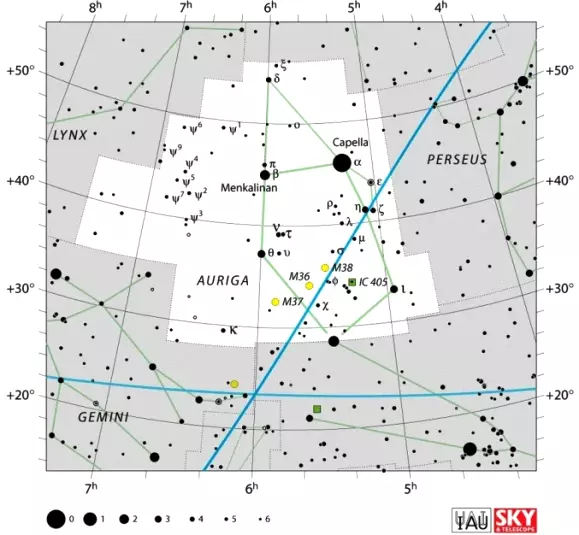
Auriga constellation map by IAU and Sky&Telescope magazine
Myth
Auriga is usually depicted as a charioteer, holding the reins of a chariot with his right hand and carrying a goat and its two young on his left arm. Even though the image of the charioteer appears in Johann Bode’s Uranographia (1801), none of the stories Auriga is usually associated with have a goat in them.
In mythology, Auriga is most frequently identified with Erichthonius, king of Athens and son of the fire god Hephaestus.
Erichthonius was raised by the goddess Athena, who taught him many skills he wouldn’t have ordinarily learned. He was the first man to tame and harness four horses to a chariot, imitating the chariot of the Sun god. Zeus was impressed and later placed Erichthonius among the stars. Erichthonius is usually credited for the invention of the four-horse chariot, the quadriga.
In another myth, Auriga represents Hephaestus himself, the lame god, who built the chariot so that he could travel anywhere he wanted, whenever he wanted, without difficulty.
In another popular myth, the charioteer is Myrtilus, son of Hermes, who served King Oenomaus of Pisa. Oenomaus had a beautiful daughter, Hippodamia, and was determined not to give her hand away to any of her suitors. He would challenge each of them to a chariot race. If he caught up with them before they arrived to Corinth, they would meet their end at his hands.
With Myrtilus driving the king’s chariot, none of Hippodamia’s suitors survived the race until Pelops, son of Tantalus, came to ask the king for his daughter’s hand. Hippodamia fell in love with Pelops at first sight and asked Myrtilus to let him win. The charioteer, who was himself in love with the king’s daughter, obeyed and tampered with the chariot’s wheels. During the race, the wheels fell off and King Oenomaus was thrown off the chariot and did not survive. Once Pelops had won the race, he cast his rival Myrtilus into the sea. Betrayed, Myrtilus cursed the house of Pelops before he drowned. It was Myrtilus’ father Hermes who placed his son’s image among the stars.
The star Capella, Alpha Aurigae, is associated with Amalthea, the goat who was foster-mother to Zeus. The name Capella is Roman and means “she-goat.” The star is located on the Charioteer’s left shoulder.
Auriga stars
Capella – α Aurigae (Alpha Aurigae)
Capella, Alpha Aurigae, is the brightest star in Auriga and the sixth brightest star in the sky. It is only 42.2 light years distant. The only two stars in the northern hemisphere that are brighter than Capella are Vega (Alpha Lyrae) in Lyra constellation and Arcturus (Alpha Boötis) in Boötes. Capella is a known source of X-rays. It is the closest first magnitude star to the north celestial pole.
Capella consists of two binary pairs of stars; a pair of large, bright G-type giants in close orbit (about 100 million km) and a pair of small, cool red dwarfs, located about 10,000 AU from the first pair.
The Capella system belongs to the Hyades moving group, a large group of stars that share a similar trajectory with the Hyades cluster, an open star cluster in the constellation Taurus.
Capella marks the Charioteer’s left shoulder or the goat he is carrying. It represents Amalthea, the goat that suckled Zeus.
Menkalinan – β Aurigae (Beta Aurigae)
Menkalinan, Beta Aurigae, is a triple star system, 85 light years distant. The brightest two components are white A-type subgiant stars and the third star is a red dwarf. The two brighter stars in the system constitute an eclipsing spectroscopic binary with a magnitude varying between 1.85 and 1.93.
Beta Aurigae is an outlying member of the Ursa Major Moving Group (Collinder 285), a group of stars (that includes most of the bright stars in Ursa Major constellation) believed to have a common origin that share common velocities in space.
The star’s traditional name, Menkalinan, comes from the Arabic phrase mankib ðī-l-‘inān which means “shoulder of the rein-holder.”
Mahasim – θ Aurigae (Theta Aurigae)
Mahasim, Theta Aurigae, is a double star located about 173 light years away. The primary component is an Alpha-2 Canum Venaticorum type variable, a chemically peculiar star with a strong magnetic field and strong strontium, silicon, or chromium spectral lines. Theta Aurigae has a mean apparent magnitude of 2.65.
The star’s traditional name, Mahasim, comes from the Arabic word for “wrist.” Theta Aurigae is also sometimes called Bogardus.
The brighter component in the system is a white A-type main sequence dwarf and the companion star is a yellow G-type main sequence dwarf. Theta Aurigae A has the apparent magnitude of 2.7 and Theta Aurigae B, 7.2. The binary star has an 11th magnitude optical companion 49 arc seconds away.
Hassaleh – ι Aurigae (Iota Aurigae)
Hassaleh, Iota Aurigae, is an orange K-type bright giant approximately 512 light years distant. It has an apparent magnitude of 2.69. The star is 127 times larger than the Sun and 7.1 times more massive. It shines with 4,581 solar luminosities with an effective temperature of 4,160 K.
Iota Aurigae was traditionally also known as Kabdhilinan or Al Kab, derived from the Arabic kaʽb ðīl-ʽinān, meaning “the ankle.” The name refers to the star’s position in Auriga, marking the left ankle of the celestial Charioteer.
Almaaz – ε Aurigae (Epsilon Aurigae)
Almaaz, Epsilon Aurigae, is another eclipsing binary star, composed of an F0 class supergiant, with a diameter 135 times that of the Sun, and an unusual companion, believed to be a large dark disk orbiting a binary star. More recent studies and observations from the Spitzer Space Telescope actually suggest that the main star is a post-asymptotic giant branch star, while the companion is a single B-class star inside a disk.
The apparent magnitude of the system drops from 2.92 to 3.93 for about 66 days every 27 years. Epsilon Aurigae is approximately 2,000 light years distant. The name Almaaz means “(billy) goat” in Arabic.
Haedus – η Aurigae (Eta Aurigae)
Eta Aurigae is a blue-white B-type main sequence dwarf located about 219 light years away. It has an apparent magnitude of 3.18.
In the constellation, the star represents one of the ‘kids’ of the goat (Capella) held by the Charioteer. Its traditional name is Haedus II (or Hoedus II) and it comes from the Latin word haedus, which means ‘kid.’ It was traditionally also called Mahasim (“wrist”), a name it shares with Theta Aurigae.
Saclateni – ζ Aurigae (Zeta Aurigae)
Zeta Aurigae is the other Haedus, or ‘kid’ held by the Charioteer. The star is formally known as Saclateni. The name comes from the Arabic phrase for “the second arm (of the Charioteer).”
Saclateni is an eclipsing binary star 790 light years distant. It consists of a red supergiant and a B8 type companion. The system’s magnitude varies between 3.61 and 3.99 with a period of 972 days.
Prijipati – δ Aurigae (Delta Aurigae)
Prijipati, Delta Aurigae, is a binary star about 140 light years from Earth. It consists of an orange K-type giant and a companion star 115.4 arc seconds away. The primary star has an apparent magnitude of 3.72 and the companion, 9.7. In Indian astronomy, the star is called Prajapati, which means “the Lord of Creation” in Sanskrit.
AE Aurigae
AE Aurigae is a runaway star (one moving through space at an unusually high velocity when compared to the neighboring stars), approximately 1,460 light years distant. It is a blue O-type main sequence dwarf and an Orion type variable (a star with eruptive, irregular variations in luminosity, usually associated with a nebula). Its luminosity varies between 5.78 and 6.08.
Along with Mu Columbae and 53 Arietis, AE Aurigae is suspected to have been ejected when two binary star groups collided. The collision presumably occurred in the Trapezium Cluster, located in the Orion Nebula (Messier 42), about two million years ago.
AE Aurigae lights the Flaming Star Nebula (IC 405, Caldwell 31, SH 2-229), an emission/reflection nebula with a magnitude of 6.0. The Flaming Star Nebula is located near Iota Aurigae.
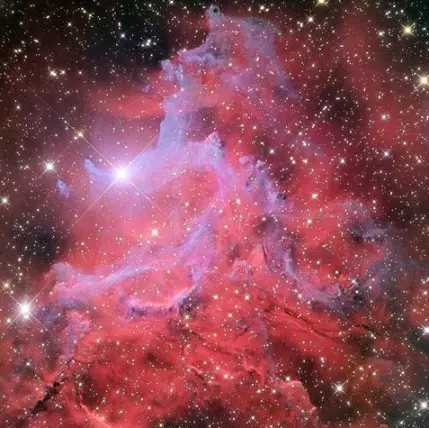
AE Aurigae and the Flaming Star Nebula (IC 405), image: Adam Block/Mount Lemmon SkyCenter/University of Arizona (CC BY-SA 3.0 US)
Other notable stars:
Al Hurr or λ Aurigae (Lambda Aurigae) is a double star, approximately 41.2 light years distant. It consists of a G-type subgiant and a companion star with a magnitude of 13.4, that lies 29 arc seconds away. The system also has two optical companions 42 and 146 arc seconds away from the primary star. The star’s name comes from the Arabic word for “the fawn.”
γ Aurigae (Gamma Aurigae) is now known as Beta Tauri and belongs to the constellation Taurus. The star’s traditional name is El Nath or Elnath. It is the nearest bright star to the galactic anti-centre.
Deep sky objects in Auriga
Messier 36 (M36, NGC 1960)
Messier 36 is a bright open cluster located in the southern region of Auriga. It was first discovered by the Italian astronomer Giovanni Batista Hodierna in the 17th century, then rediscovered by Le Gentil about a century later, and finally included by Charles Messier in his catalogue in 1764.
M36 contains at least 60 stars and has an apparent magnitude of 6.3. The brightest members of the cluster are B2 type stars with an apparent magnitude of 9.
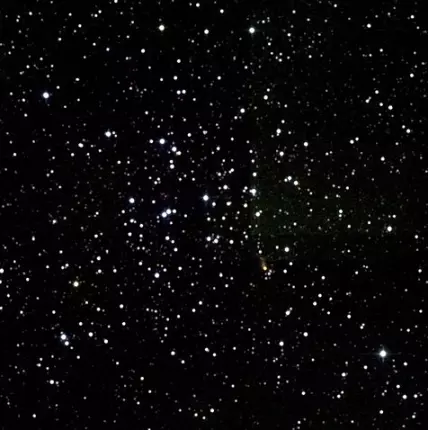
Messier 36 (NGC 1960), Atlas Image mosaic courtesy of 2MASS/UMass/IPAC-Caltech/NASA/NSF
M36 is approximately 4,100 light years distant and about 14 light years in diameter. It resembles Messier 45 (the Pleiades) in Taurus, but is too distant to appear as conspicuous in the night sky.
The estimated age of M36 is 25 million years. The cluster does not contain any evolved red giant stars.
Messier 37 (M37, NGC 2099)
Messier 37 is another bright open star cluster in Auriga. It was discovered along with M36 and M38 by Giovanni Hodierna. The cluster is between 3,600 and 4,700 light years from Earth and contains some 500 stars, about 150 of which are brighter than magnitude 12.5.
M37 contains about a dozen red giants and its estimated age is 300 million years. The hottest main sequence star in the cluster is of spectral type B9V.
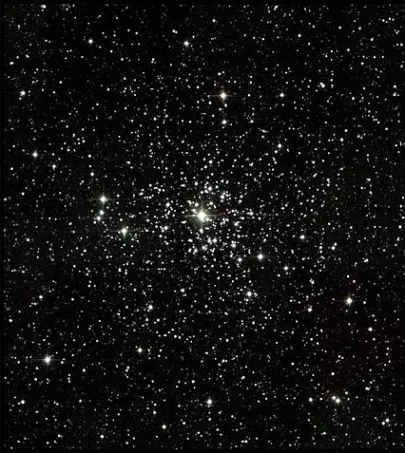
Messier 37 (NGC 2099), Atlas Image mosaic courtesy of 2MASS/UMass/IPAC-Caltech/NASA/NSF
The cluster has an apparent magnitude of 5.6 and is 24 light years in diameter. It is the brightest of the three clusters discovered by Hodierna.
Messier 38 (M38, NGC 1912)
Messier 38 can be observed only 2.5 degrees northwest of M36. It is an open cluster, approximately 4,200 light years distant.
Like M36 and M37, it was originally discovered by the Italian astronomer Giovanni Batista Hodierna in the 17th century and then independently discovered again by the French astronomer Le Gentil in 1749. Charles Messier later included the cluster, along with M36 and M37, in his catalogue in 1764.
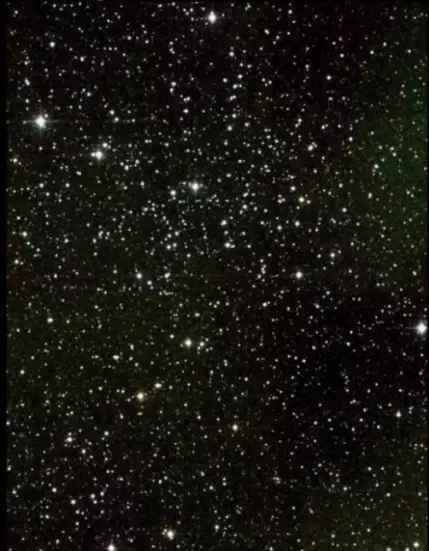
Messier 38 (NGC 1912), Atlas Image mosaic courtesy of 2MASS/UMass/IPAC-Caltech/NASA/NSF.
The brightest stars in M38 form an oblique cross, or the letter Pi. The brightest member is a G0 class yellow giant with an apparent magnitude of 7.9, which at that distance translates into luminosity 900 times that of the Sun.
The cluster is about 25 light years (20′) in diameter. Its estimated age is 220 million years.
Flaming Star Nebula (IC 405)
The Flaming Star Nebula, also known by the designations IC 405, SH 2-229, and Caldwell 31, can be seen near the open cluster M38, the star Iota Aurigae, or the emission nebula IC 410.
The Flaming Star Nebula is an emission/reflection nebula that surrounds the star AE Aurigae. It lies 1,500 light years from Earth and has an apparent magnitude of 6.0.
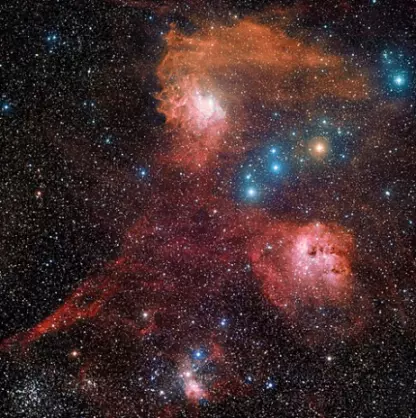
Nebulae IC 405, IC 410, and IC 417 in the constellation Auriga. Near the lower left corner, open clusters Messier 38 and NGC 1907 are easily identifiable. Image: Giuseppe Donatiello (CC0 1.0)
Tadpole Nebula (IC 410)
The Tadpole Nebula (IC 410) is an emission nebula, one that slightly resembles the Rosette Nebula in the constellation Monoceros. The nebula surrounds the open cluster NGC 1893. It is approximately 2,200 light years distant and has an apparent magnitude of 13.